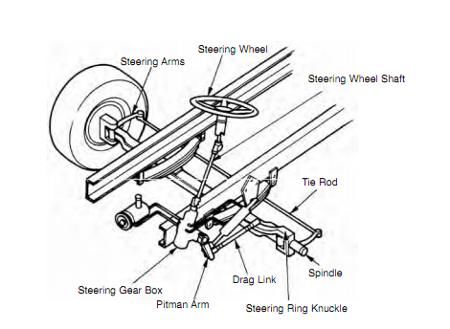Review Questions - Click On The Picture To Begin...

- While it's important to perform daily vehicle inspections, there are no federal regulations requiring inspections be done on each day the vehicle is driven
- A certified mechanic may do the vehicle inspection instead of the driver
- Any CDL holder can deem a vehicle safe to operate as long as they sign off on the daily inspection report
- The driver is always responsible for completing their own daily inspections
Quote From The CDL Manual:
The most important aspect of traffic safety for yourself and others who share the road with you is that you personally inspect your vehicle. A vehicle defect found during an inspection could save you problems later. You could have a breakdown on the road that will cost you time and money, or even worse, an accident caused by the defect.
Federal and state laws require that drivers inspect their vehicles. Federal and state inspectors also may inspect your vehicles. If they judge a vehicle to be unsafe, they will put it "out of service" until it is repaired.
TruckingTruth's Advice:
A daily vehicle inspection is crucially important. Many drivers will forgo an inspection if they are pressed for time, but this is extremely dangerous. You are not safe to drive until you've done an inspection of your vehicle.
- Anything less than 5 degrees of free play is acceptable
- Anything less than 20 degrees of free play is acceptable
- No amount of free play is acceptable
- Anything less than 10 degrees of free play is acceptable
Quote From The CDL Manual:
Things to check on the steering system:
- Missing nuts, bolts, cotter keys or other parts.
- Bent, loose or broken parts, such as steering column, steering gear box or tie rods.
- If power steering equipped-check hoses, pumps and fluid level for leaks.
- Steering wheel play of more than 10 degrees (approximately 2 inches movement at the rim of a 20-inch steering wheel) can make it hard to steer.
TruckingTruth's Advice:
Be sure to memorize that 10 degrees of free play is the maximum amount allowed. This may show up on your written exam and you will need to know it for the pre-trip exam.
- Watch gauges for signs of trouble
- Use your senses to check for problems (look, listen, smell, feel)
- Check critical items when you stop
- All of these should be checked during a trip
Quote From The CDL Manual:
Trip Inspection For safety you should:
- Watch gauges for signs of trouble.
- Use your senses to check for problems (look, listen, smell, feel).
- Check critical items when you stop:
- Tires, wheels and rims
- Brakes
- Lights and reflectors
- Brake and electrical connections to trailer
- Trailer coupling devices
- Cargo securement devices
- 2/32-inch
- 4/32-inch
- 8/32-inch
- 1-inch
Quote From The CDL Manual:
You need at least 4/32-inch tread depth in every major groove on front wheels (steer tires) and 2/32-inch depth on other tires. No fabric should show through the tread or sidewall.
TruckingTruth's Advice:
It is extremely important to memorize legal tire tread depths. There is a very good chance this will show up on the exam and will need to be memorized for the pre-trip exam as well.
- 6/32-inch
- 2/32-inch
- 4/32-inch
- 1-inch
Quote From The CDL Manual:
You need at least 4/32-inch tread depth in every major groove on front wheels and 2/32-inch depth on other tires. No fabric should show through the tread or sidewall.
TruckingTruth's Advice:
You absolutely must memorize all legally allowed tread depths. This will probably show up on your written exam and will definitely need to be memorized for the pre-trip exam.
- 1/16-inch
- 1/2-inch
- 1/8-inch
- 1/4-inch
Quote From The CDL Manual:
Things to check for on brake drums or shoes:
- Cracked drums.
- Shoes or pads with oil, grease or brake fluid on them (brake pad more than 1/4-inch thick).
- Shoes worn dangerously thin, missing or broken.
TruckingTruth's Advice:
This needs to be memorized, not only for the written exam but also for the pre-trip exam.
- Finding defects could prevent an accident due to faulty equipment
- All of these are important reasons for doing a daily vehicle inspection
- Federal and state laws require that drivers inspect their vehicles
- A proper inspection could avoid a breakdown
Quote From The CDL Manual:
The most important aspect of traffic safety for yourself and others who share the road with you is that you personally inspect your vehicle. A vehicle defect found during an inspection could save you problems later. You could have a breakdown on the road that will cost you time and money, or even worse, an accident caused by the defect.
Federal and state laws require that drivers inspect their vehicles. Federal and state inspectors also may inspect your vehicles. If they judge a vehicle to be unsafe, they will put it "out of service" until it is repaired.
- Gear box
- Air compressor
- Tie rods
- Pumps
Quote From The CDL Manual:
Things to check in the steering system:
- Missing nuts, bolts, cotter keys or other parts.
- Bent, loose or broken parts, such as steering column, steering gear box or tie rods.
- If power steering equipped-check hoses, pumps and fluid level for leaks.
- Steering wheel play of more than 10 degrees (approximately 2 inches movement at the rim of a 20-inch steering wheel) can make it hard to steer.









 TT On Facebook
TT On Facebook